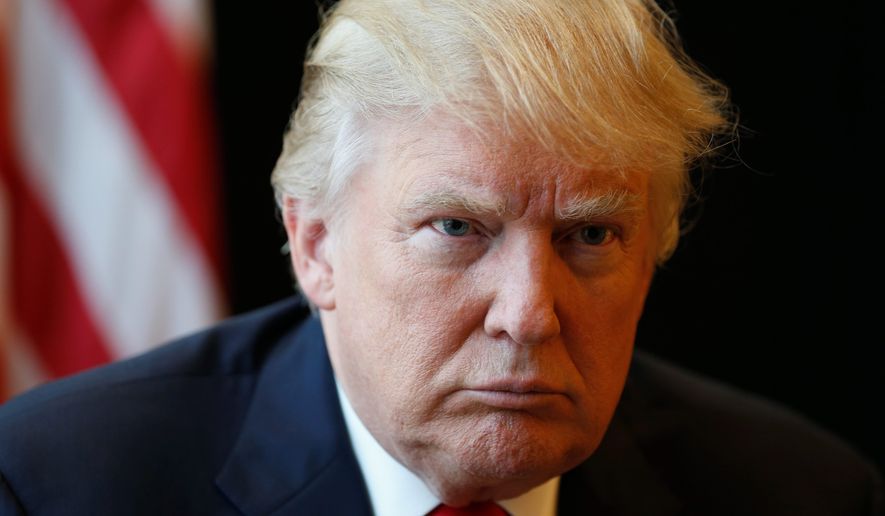Donald Trump continues to be competitive in big key swing states in November’s presidential election, according to the latest polling that shows the billionaire businessman and presumptive Republican nominee has indeed scrambled the electoral map.
States that haven’t been in play for decades, such as Pennsylvania, appear to be within his reach. But long-solid red states such as Arizona could be slipping, and Mr. Trump also is pushing Colorado and Virginia, which President Obama won in the past two elections, deeper into the blue.
All told, at least a dozen states have produced polls since May showing Mr. Trump and likely Democratic nominee Hillary Clinton within 5 percentage points of each other.
Most critical are three swing states — Pennsylvania, Ohio and Florida — where Mr. Trump is running even or slightly ahead, according to a Quinnipiac University Poll released Wednesday morning. He holds a 3-point lead in Florida, 42-39 percent; a 2-point lead in Pennsylvania, 43-41 percent; and is tied with Mrs. Clinton in Ohio, with each at 41 percent in a head-to-head matchup.
The polling was conducted after the FBI released its report last week saying Mrs. Clinton may have broken federal laws in mishandling classified material while at the State Department — though the Obama Justice Department declined to prosecute her.
“Donald Trump enters the Republican Convention on a small roll in the three most important swing states in the country,” said Peter A. Brown, assistant director of the Quinnipiac University Poll.
“While there is no definite link between Clinton’s drop in Florida and the U.S. Justice Department decision not to prosecute her for her handling of emails, she has lost ground to Trump on questions which measure moral standards and honesty.”
But the polling is anything but clear at this point.
Hours after Quinnipiac’s surveys were released, a Marist/NBC/Wall Street Journal poll showed Mrs. Clinton up 9 points in Pennsylvania.
Even as Mr. Trump tries to compete in the big swing states, he is suffering in the middle-sized states. A Monmouth University poll showed Mrs. Clinton with a 13-point lead in Colorado, and a Fox News poll showed her up 10 points in that state and 7 points in Virginia.
The slew of polls comes as both parties prepare for their national conventions.
G. Terry Madonna, director of the Center for Politics and Public Affairs at Franklin and Marshall College in Pennsylvania, and director of the Franklin and Marshall Poll, said pre-convention surveys are “always a little mystifying” and the real contours of the race will emerge a couple of weeks afterward.
Pennsylvania is a particularly big prize this year. If Mr. Trump can capture it, Ohio and Florida and hold the rest of the states won by Mitt Romney in 2012, he would win the White House. Ohio and Florida voted Republican in 2000 and 2004 and have Republican governors, but Pennsylvania has proved more elusive for the party, having gone blue in every presidential election since 1988.
Republicans regularly predict success in Pennsylvania only to see those efforts crater by the fall.
But Mr. Madonna said this year could be different.
“Right now, I would still continue to think it leans Democratic. I wouldn’t rule out that Trump could win in this unpredictable election year,” he said.
Analysts have said Mr. Trump’s appeal to Rust Belt voters could deliver victory in Pennsylvania, Michigan, Wisconsin and Ohio. But Mr. Madonna said Mr. Trump will have to prove he can dramatically boost turnout in Rust Belt counties in Pennsylvania and make inroads in the Philadelphia suburbs.
Mrs. Clinton will try to recapture the Obama magic that won 93 percent of black voters, with massive turnout, in 2012. Mr. Trump, meanwhile, will try to avoid an implosion on the campaign trail that might make him unacceptable to too many voters.
Given all the factors, Mr. Madonna said, it makes sense for Mr. Trump to visit and spend money in Pennsylvania — something Mr. Romney didn’t do until the end of the 2012 race, en route to a 5-point loss.
“I don’t think there’s any question it’s in play,” said Chris Bravacos, a Republican Party strategist and president of the Bravo Group who was a backer of Sen. Marco Rubio of Florida in the Republican primary.
Mr. Bravacos said Mr. Trump has reshuffled the usual political coalitions, so predicting the outcome of the election at this point is a fool’s errand.
“You had a hurricane of a primary season from both [Democratic candidate Bernard] Sanders and Trump, and what’s left on a beach after a hurricane is a new beach. There’s a new emerging framework here,” he said.
That’s true nationwide, where traditional Republican voters have indicated that they cannot support Mr. Trump in many instances but are being replaced by new and disaffected voters picking the maverick businessman over Mrs. Clinton, whom they view as too much of an establishment candidate.
Whether that math works out for Mr. Trump remains to be seen.
That’s one reason the polling in Colorado and Virginia is troublesome for Republicans. The same Monmouth poll showing Mr. Trump trailing by 13 points in Colorado also shows the Republican Senate hopeful there trailing incumbent Democratic Sen. Michael Bennet by 13 points.
“Clinton does better among practically every demographic in Colorado than she does nationally,” said Patrick Murray, the poll’s director. “It is way too early to call, but if this dynamic holds, she could end up with the largest electoral margin for a Democrat here since 1964.”
• Stephen Dinan can be reached at sdinan@washingtontimes.com.
• David Sherfinski can be reached at dsherfinski@washingtontimes.com.




Please read our comment policy before commenting.